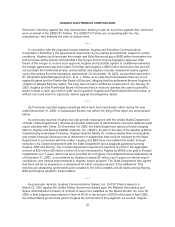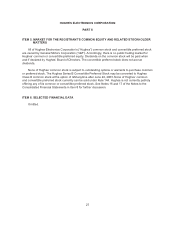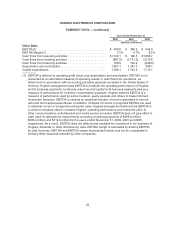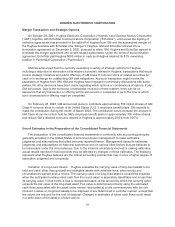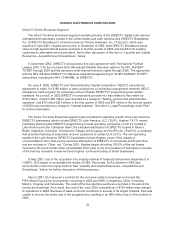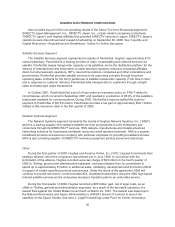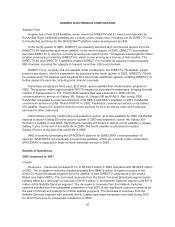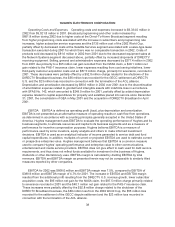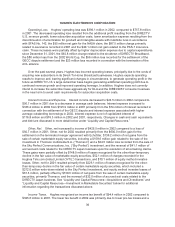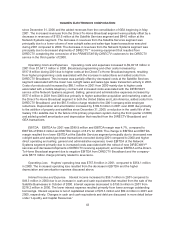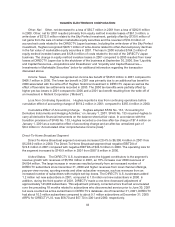DIRECTV 2002 Annual Report Download - page 44
Download and view the complete annual report
Please find page 44 of the 2002 DIRECTV annual report below. You can navigate through the pages in the report by either clicking on the pages listed below, or by using the keyword search tool below to find specific information within the annual report.HUGHES ELECTRONICS CORPORATION
DLA’s 2002 operating results have been adversely affected by the economic and political
instability throughout Latin America, as well as the ongoing devaluation of several local currencies. The
unfavorable and volatile conditions in certain Latin American countries has made it difficult for DLA to
continue to develop its business, generate additional revenues, add new subscribers or achieve
profitability. DLA has implemented steps in an attempt to improve its financial results. DLA has, among
other steps, (i) renegotiated major supplier contracts, including programming contracts, (ii) reduced
general and administrative expenses, (iii) attempted to eliminate all non-critical business activities,
(iv) reduced investment in subscriber acquisition costs, as appropriate, in each market, (v) slowed
subscriber growth, (vi) implemented local currency price adjustments to increase average monthly
revenue per subscriber (“ARPU”) to offset devaluation and (vii) minimized capital expenditures. DLA’s
business could deteriorate if conditions worsen, continue for a sustained period or spread to other Latin
American countries. Further, changes in the leadership or in the ruling party in the countries in which
DLA operates may affect the economic programs developed under the prior administration, which in
turn may adversely affect DLA’s business, operations and prospects in these countries.
In January 2003, DLA announced the commencement of further discussions with certain
programmers, suppliers and business associates to address DLA’s current financial and operational
challenges. The agreements which DLA is seeking to restructure include certain long-term or exclusive
programming agreements which have resulted in payment obligations substantially in excess of the
current economic value of the programming to DLA. DLA has ceased making payments under certain
of these agreements and has received notices of default relating to approximately $32 million claimed
to be owed to programmers and a claim that DLA’s restructuring had resulted in an acceleration of an
obligation to repurchase a 4% equity interest in DLA for $195 million. DLA does not believe that the
purchase obligation has been accelerated. All such amounts correspond to agreements that are
currently under renegotiation. If DLA does not comply with its obligations under its programming
contracts and is unsuccessful in reaching a settlement with the relevant programmers, such
programmers could seek to terminate the programming contracts, which would result in a loss of such
programming to DLA. If the discussions do not result in a reasonable agreement in the near future,
DLA has indicated that it would consider other options, including restructuring the company under
Chapter 11 of the U.S. bankruptcy law. If DLA initiates proceedings under Chapter 11 of the U.S.
bankruptcy law, it could reject some or all of its long-term programming agreements (as well as other
non-essential executory contracts), in which event the programming related to such rejected
agreements would no longer be available to DLA. This could result in increased churn or reduced
demand for the DLA service, which would be a consideration for DLA in determining which
programming contracts to reject in the event of Chapter 11 bankruptcy proceedings. A filing under
Chapter 11 of the U.S. bankruptcy law could result in a charge in a future period that could be material
to Hughes’ consolidated results of operations and financial position.
The results of operations for DIRECTV Broadband, formerly a provider of digital subscriber line
(“DSL”) services, have been included in Hughes’ financial information since April 4, 2001, the date of
its acquisition.
On December 13, 2002, Hughes announced that DIRECTV Broadband would close its high-speed
Internet service business in the first quarter of 2003 and transition its existing customers to alternative
service providers. As a result, in December 2002, Hughes notified approximately half of DIRECTV
Broadband’s 400 employees of a layoff, with a minimum of 60 days notice during which time they were
paid, followed by receipt of a severance package. The remaining employees worked with customers
during the transition and assisted with the closure of the business, which occurred on February 28,
2003. As a result, Hughes recorded a fourth quarter 2002 charge of $92.8 million related to accruals for
employee severance benefits, contract termination payments and write-off of customer premise
equipment. This charge was recorded in “Selling, general and administrative expenses” in the
Consolidated Statements of Operations and Available Separate Consolidated Net Income (Loss).
See “Liquidity and Capital Resources—Acquisitions and Divestitures” below, for further discussion
of the DIRECTV Broadband transactions described above.
34



